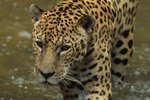
The river otter and the nutria, also known as the coypu, can occupy the same sort of habitat but they are very different animals, contrasting in almost every aspect of their behavior and physiology. There is another possible source of confusion: Although in English “nutria” means "coypu," in Spanish it also means “otter.”
Physical Appearance and Taxonomy
Physically, the two animals are about the same length, about 2 feet not including tail, but of very different shapes. The nutria is rounded and solid, whereas the river otter is slender and elongated. The coypu (Myocastor coypus) has typical rodent adaptations, including large, strong front teeth for gnawing.
River otters are mustelids, in the same carnivorous family as ferrets, mink, stoats and weasels. The North American river otter (Lontra canadensis) is the species native to the United States. Otters in other parts of the world are quite similar.
Otters have elongated bodies; sharp, catlike teeth; and slightly webbed feet for swimming. Their tails are somewhat flattened, although not as much as the nutria's. The other obvious visible similarity is that otters and nutrias both have small, rounded ears set close to the head because of their semiaquatic lifestyles.
Geographical Distribution
The nutria is native to Argentina, Bolivia, Brazil, Uruguay and Paraguay. Its range now includes parts of North America, Asia, Africa and Europe. These nutrias are the descendants of fur farm escapees who found comfortable niches in their new habitats.
The thick, waterproof coat of the river otter, like that of the nutria, was valuable in the fur trade. The North American river otter range extends from Alaska and northern Canada down to the south-western states. The species was exterminated from large areas in the past because of uncontrolled trapping. River otters now have been reintroduced to much of the eastern United States.
Diet
The diets of these two animals are about as different as possible. Like many rodents, the nutria is omnivorous. Although nutrias' primary diet is aquatic vegetation, they’ll also eat other available snacks, including snails and crustaceans.
River otters are true carnivores, eating mainly fish but also small amphibians, reptiles and invertebrates.
Behavior
Both animals are semiaquatic. Although they can move pretty well on land, they are rarely found far from a body of fresh water, mainly rivers. Swimming otters and nutrias can be mistaken for each other from a distance, because only a small amount of the animal is visible above the water.
Although you might see them during the day, river otters are mostly nocturnal. They are not especially social, although mothers and cubs form family groups until the cubs are about a year old. Nutrias are also nocturnal but much more social, living in structured colonies with an alpha male and female at the top.
Conservation
Throughout much of its current range, the coypu is more an invasive creature than an endangered one, competing with native animals and eating its way through a lot of vegetation. But in Argentina the native population of coypu is endangered. Overall, coypu are under no threat, and the International Union for the Conservation of Nature lists it as of “least concern” on the Red List of Endangered Species.
The river otter has had a harder time, but conservation efforts and a crackdown on trapping have allowed some populations to recover. The IUCN now lists North American river otters as of least concern, with a stable population trend. Other species of otter are considered to be at greater risk, with decreasing populations.
References
Photo Credits
-
Nutria image by Petra Kohlstädt from Fotolia.com
Writer Bio
Judith Willson has been writing since 2009, specializing in environmental and scientific topics. She has written content for school websites and worked for a Glasgow newspaper. Willson has a Master of Arts in English from the University of Aberdeen, Scotland.



